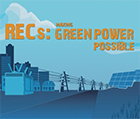Renewable Energy Certificates (RECs)
- What is a renewable energy certificate (REC)?
- How do RECs work?
- What is the legal basis of RECs?
- What is REC Arbitrage?
- What is the Difference Between RECs and Offsets?
What is a renewable energy certificate (REC)?
A renewable energy certificate, or REC (pronounced: rěk), is a market-based instrument that represents the property rights to the environmental, social and other non-power attributes of renewable electricity generation. RECs are issued when one megawatt-hour (MWh) of electricity is generated and delivered to the electricity grid from a renewable energy resource.
RECs include several data attributes, including:
- Certificate Data
- Certificate type
- Tracking system ID
- Renewable fuel type
- Renewable facility location
- Nameplate capacity of project
- Project name
- Project vintage (build date)
- Certificate (generation) vintage
- Certificate unique identification number
- Utility to which project is interconnected
- Eligibility for certification or RPS
- Emissions rate of the renewable resource
*Note: This list is not exhaustive and, depending on the market in which the REC is generated, other attributes may be associated with the certificate.
How do RECs work?
 Because the physical electricity we receive through the utility grid says nothing of its origin or how it was generated, RECs play an important role in accounting, tracking, and assigning ownership to renewable electricity generation and use. On a shared grid, whether from on-site or off-site resources, RECs are the instrument that electricity consumers must use to substantiate renewable electricity use claims. The short video to the right describes the importance and role of RECs in making green power possible for electricity consumers nationwide.Exit
Because the physical electricity we receive through the utility grid says nothing of its origin or how it was generated, RECs play an important role in accounting, tracking, and assigning ownership to renewable electricity generation and use. On a shared grid, whether from on-site or off-site resources, RECs are the instrument that electricity consumers must use to substantiate renewable electricity use claims. The short video to the right describes the importance and role of RECs in making green power possible for electricity consumers nationwide.Exit
What is the legal basis of RECs?
RECs are the accepted legal instrument through which renewable energy generation and use claims are substantiated in the U.S. renewable energy market. RECs are supported by several different levels of government, regional electricity transmission authorities, nongovernmental organizations (NGOs), and trade associations, as well as in U.S. case law. For additional information, please see the Center for Resource Solutions paper on "The Legal Basis for Renewable Energy Certificates (PDF) (25 pp, 351K)."Exit
What is REC Arbitrage?
REC Arbitrage is a green power procurement strategy used by electricity consumers to simultaneously meet two objectives: 1) decrease the cost of their renewable electricity use and 2) substantiate renewable electricity use and carbon footprint reduction claims. The strategy is used by consumers installing self-financed renewable electricity projects or consumers who purchase renewable electricity directly from a renewable electricity project, such as through a power purchase agreement (PPA).
What is the Difference Between RECs and Offsets?
Both offsets and RECs represent the environmental benefits of certain actions that can help mitigate GHG emissions. Offsets represent a metric ton of emissions avoided or reduced; RECs represent attributes of 1 MWh renewable electricity generation. Offsets and RECs, however, are fundamentally different instruments with different impacts, representing different criteria for qualification and crediting in the context of inventory or emissions footprint. For additional information, please see the Offsets and RECs: What's the Difference? guidance document.
